The Northern Belle
Clive and I wrote up this train under LNER Principal Expresses on pages 166-168. Space didn't allow much to be said about the history of individual carriages so here are some notes, starting from the front end of the train. But first, some pictures of the train itself:
Use of the kitchen car revised and final part added about the day and night passenger carriages.
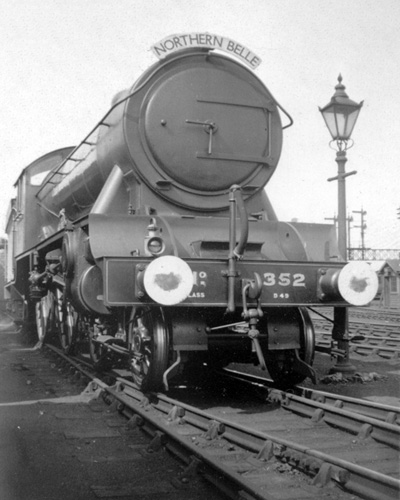
This isn't really part of my narrative but a loco picture of which I have an original print. The handwriting on the back may be H. Gordon Tidey's but I cannot be sure. Taken on 22nd June 1933 it shows D.49 No 352 The Meynell at Scarborough. It was allocated to York at the time and may have been paired with another example of the class from that shed. Photo: Author's collection.
Click on the image for an enlargement

A view from 1934 shows the train at Barnard Castle for the first overnight stop. K3 No 1300 has the day portion with the 1st class sleeping cars alongside. Behind the tender is the staff BFK and SLT. Photo: Photomatic.
Click on the image for an enlargement
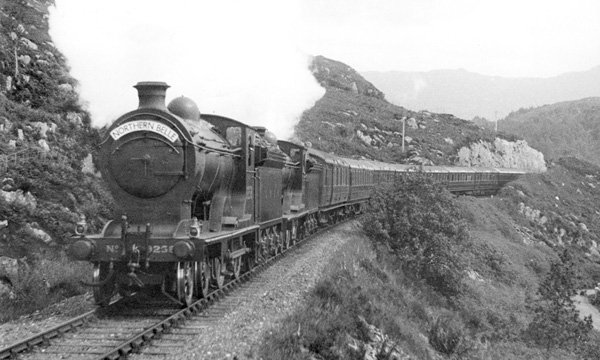
Another view of the day portion in 1934 shows a pair of ex-NBR D34s with the "Northern Belle" at Glenfinnan Viaduct led by No 9258 Glen Roy. Photo: Cecil Ord collection.
Click on the image for an enlargement
The carriages are described in the sequence from behind the tender:
- staff carriages - catering carriages - day carriages - sleeping cars and baggage van.
The formation was manipulated, for cleaning, for example, and was often divided into "day" and "night" portions:
The 1st Brake (staff)
As a type, the 1st Brake isn't recognised very much by modellers although it was much used on the GN Section and Clive and I described its role in GNML formations under "Principal Services", and in the Leeds-Glasgow express. Michael Harris also described their uses in his final book (1998).
There were four types altogether:
BFK(2) BFK(3) BFK(4) BFK(5)
A key feature of the 1st brake in general service wasn't just in the different seating capacities because where there were fewer seats, the van capacity was larger - a significant consideration for the well-heeled who more than most passengers, tended not to travel light. It was also useful where a small number of 1st class seats needed to be added and a lot of van space, rather than a BG.
In the "Northern Belle" one was required as a day carriage for the staff and the BFK(5) to D.29 was chosen. Only three had been built, Nos 4203/4/6, and either of the first two was employed, placed at the outer end of the train, behind the loco. It's well seen behind K3 No 1300 at Barnard Castle in 1934 (see above). The company decided that as the passenger accommodation was all-1st class, why not treat the staff the same way?
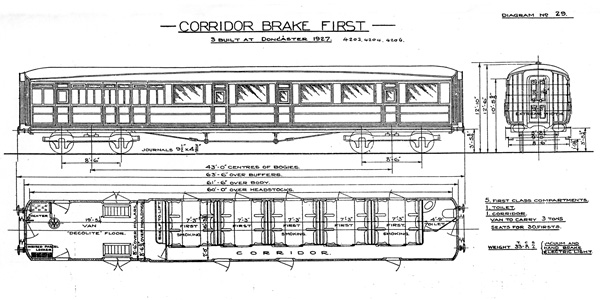
The Diagram shows a pretty conventional Gresley 61'6" side-door design with the compartments a generous 7'3" wide, compared with 6'2" for the 3rd class. It was built in 1927 during a period when the guard's ducket was omitted. The van space was noticeably small but the staff would have kept their main possessions in the staff sleeping car (which was a 3rd class one - which was probably easier to source). Author's collection.
Click on the image for an enlargement

An official view of D.29 shows No 4204, one of the two used with the "Northern Belle". Orthochromatic film was used so the beauty of the teak panelling and how well it was matched shows very well. These carriages would still have been relatively new when placed in the "Northern Belle" and it's not hard to imagine how pleased the staff would have been.
The abundance of external doors may have been useful for main line services but the drawback here is evident with restricted views out of the compartments. End-vestibule designs (with picture windows in the compartments as well) were more suitable but at the time, only provided in Open carriages. Author's collection.
Click on the image for an enlargement
The 3rd class sleeping car (staff)
At first, sleeping cars were 1st class and when the LNER began serving 3rd class passengers, the sleeping cars were convertible for day or night use. In 1931 proper night-only compartments were introduced and the length extended to 66'6". This was quite an important type with a far higher capacity than the 1st class sleeping cars and it was to do sterling service through LNER and BR days. They lasted until the early 1960s.
One was used in the "Northern Belle" for the staff. So many 1st class sleeping cars were required for the paying passengers that the company was forced to provide a 3rd class one for the staff, although it was a recently-built one with non-convertible compartments, again with 4 bunks in each one (the 1st class cars had single berths). It could accommodate 32 individuals and I imagine that there may have been a pecking order in the "Belle" with the more senior staff sharing in pairs, or even been granted single occupancy.
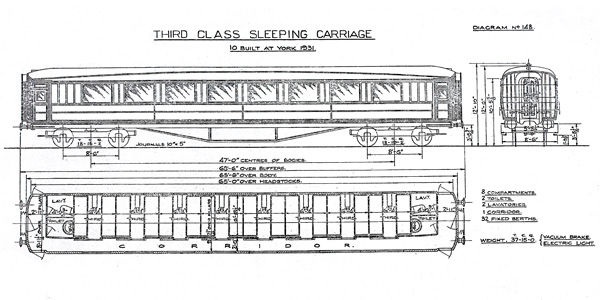
The Diagram shows the new policy of fixed compartments and the increased length of 66'6". Another feature was a change from separate lavatories and toilets on opposite sides of the corridor to both together - but still with separate doors. Albeit clumsy to a modern eye, it would have maximised their usefulness, especially in normal service where there could be 32 passengers vying to use them.
Ten were built in 1931, nos. 1336-44 and 1346. The one chosen for the "Northem Belle" in 1934 was 1344. Author's collection.
Click on the image for an enlargement
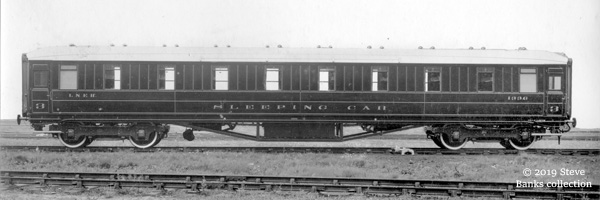
The view of No 1336 from the cabin side shows how wide the four-berth compartments were with a single small window between the berths. The length of 66'6" is not immediately apparent. It was one of the first designs to have steel angle trussing. Bogies were the 8'6" heavy type. Darlington Engineer's Office, author's collection.
Click on the image for an enlargement

The other side, the corridor side, looks more familiar and its length shows, too. These carriages were longer than the 12w restaurant cars built by the GNR (65'6"). York Drawing Office, author's collection.
Click on the image for an enlargement
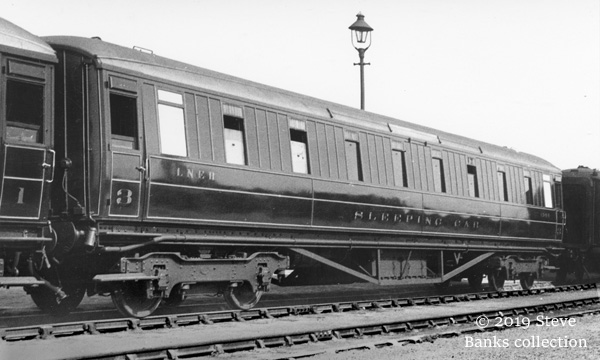
And here is a picture of No 1344, the one used with the "Northern Belle" in 1934. Note that the cabin windows had droplights, several of which are partially lowered, and that they were vertical (hence the disparity with the radiussed body). The ventilation is barely visible in the official picture and can can be identified here as Stone's with the droplight pane going all the way behind it. Some subtle adjustment was possible. Real Photographs, author's collection.
Click on the image for an enlargement
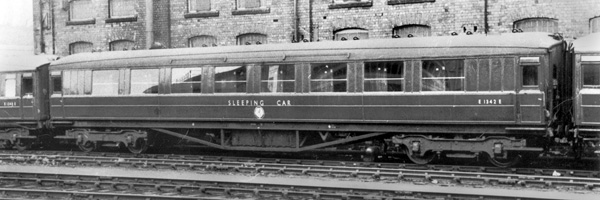
Finally, a BR-period view of E1342E at Doncaster Works, seen from the corridor side in BR maroon livery, complete with BR roundel as befitted a carriage with a certain pedigree. Photo: R.S. Carpenter.
Click on the image for an enlargement
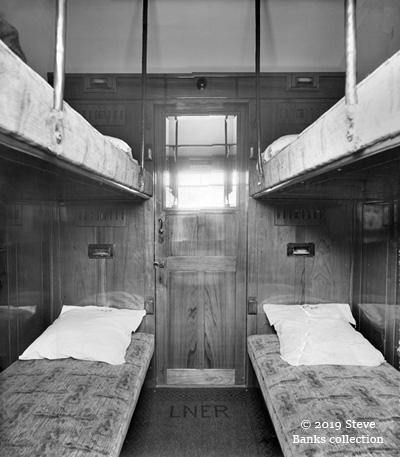
Two pictures of the interior have survived although both have required extensive repair and correction. The subject was quite difficult, after all, and drawing office prints suffered handling damage. This is the Doncaster version which was taken during the day, hence the unkind reflections in the mirror on the door. The four fixed berths can be seen. Author's collection.
Click on the image for an enlargement

The second view was taken by York with no daylight, hence the neutral reflection in the mirror on the door. It's a more pleasing picture which also shows the blankets. Only 1st class passengers were provided with sheets.. Also, whereas the higher class was provided with two pillows, the lower class got a single one, but so large that it could be folded. Author's collection.
Click on the image for an enlargement
Revised:
The Kitchen Car
In 1914 the GNR built a 53'6" kitchen car for the "Flying Scotsman" that was all-steel following public concern after disastrous fires which took many lives after accidents. Actually, some of the framing around the recessed doors was wooden and it was not a monocoque design: trussing was still required. Three were built, at York, and after replacement with Restaurant Triplet Sets in 1924, they were cascaded to the GN- and GC-Sections for use with top-end excursions, as Nos 42182 and 42183 and No 52039, respectively. Here is the Diagram:

Diagram EC.80A showing the layout with twin pantries, one for each class: presumably different standards of food were carried; this division was not to be repeated. At one end there was a compartment and lavatory for the staff. Numbers as built were 211-213. Source: Author's collection.
Click on the image for an enlargement
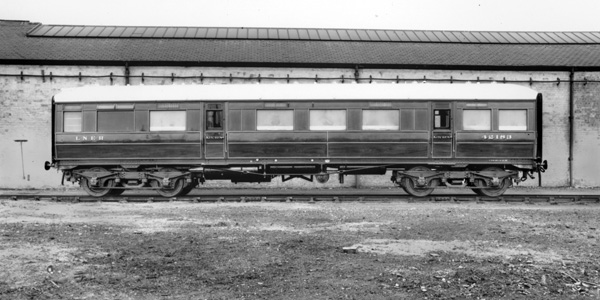
This view of cascaded No. 42183 was taken in 1929 and shows the condition in which it was to serve in the "Northern Belle". Photo: Author's collection.
Click on the image for an enlargement

I've added this detail view to show the beading, which being made of steel strip, was flat. The company went to some trouble to maintain its house style of panelled teak and this "beading" would have been screwed onto the sides. Photo: Author's collection.
Click on the image for an enlargement
When the "Northern Belle" started running in 1933, one was employed at the staff end of the train, in 1933 being No 42183 as shown above.
The modelling options - An etched brass kit is available from RDEB (via Wizard Models).
Click on the image for an enlargement
New addition:
Day and night carriages for the passengers
There were several kinds and where covered in detail elsewhere and to avoid repetition, I've placed links below.
The 1st Open Dining Cars
A pair of these was provided behind the kitchen car with a dual purpose: to serve breakfast and, if necessary, later meals, and as day cum observation cars for which unobstructed views their large picture windows and well upholstered seats were ideal.

All the LNER 1st Opens were built for use as 1st class dining cars and at first, they were even branded "Restaurant Car" (dropped later). Diagram 4 shows the general layout with 2:1 seating and only 42 seats in the carriage. Each bay was a generous 7'3" wide. Note how there was only room for a single lavatory and how cramped it was. A later Diagram recognised this and added almost 6". Some of this early version on turnbuckle trussing were provided for the "Northern Belle". Author's collection.
Click on the image for an enlargement

No.10005Y (later 21509) was an example of D.4 built in 1925 and shows the opulence and excellent visibility. Photo: author's collection.
Click on the image for an enlargement
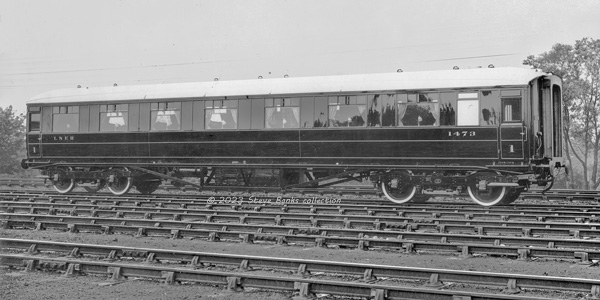
D.262 was a later version built at York for the EC, GN and GC fleets. This example of No 1473 (for the EC) was photographed with an elegant sylvan backdrop. Note the table lamps provided in the 1st class cars and hanging curtains. The 3rd class opens were more basic.
Click on the image for an enlargement
Toilet 3rd and 1st saloon
The former was deployed, now in its final condition with ladies room, hair dressing saloon and buffet, borrowed from the Flying Scotsman next to an FK - but that was soon replaced by a more convivial ex-GNR 1st saloon with large "picture windows" on both sides and occasional tables, advertised as a writing room. This pair of day coaches shows well in the photo on Glenfinnan Viaduct below:
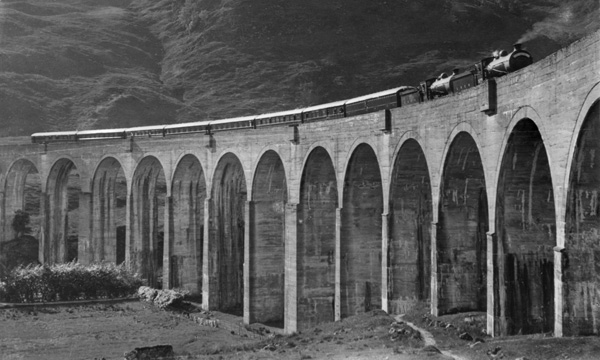
In this view from 1934, the day portion of the "Northern Belle" is crossing Glenfinnan Viaduct behind two D34s with No 9221 Glen Orchy leading. Photo: Photomatic.
The Kitchen Car is third from the rear, the whole train being:
BG, FSal*, TK**, FO, FO, RK, SLT, BFK
* 1st Saloon ex-GNR ** Toilet 3rd D.23A
1st sleeping cars
The 65'6" version with a shower was probably the most luxurious sleeping car in the country and is covered at length in a separate topic.
Baggage car
An all-steel BG of 1927 was deployed and is also covered in a dedicated topic.
Related links
Ex-GNR saloons - are here (sections 6,7).


